I know there are several quilters that are well into the process of creating their own Vintage Linens quilt! Thank you for sending pictures of your awesome progress! Recently Elaine Marie on Facebook asked where I get my vintage linens. Here’s my reply: “I’m rather addicted to: eBay, every junk store in Houston, every antique mall/store in Texas and sometimes my bffs give me awesome things! It seems that all of my friends know I love vintage linens so if they have the task of cleaning out a relatives home, I am so blessed that they often think of me!”
Below is one of my very favorite blocks in this project.

The colors of my fabrics and the colors in this vintage doily work so well together!
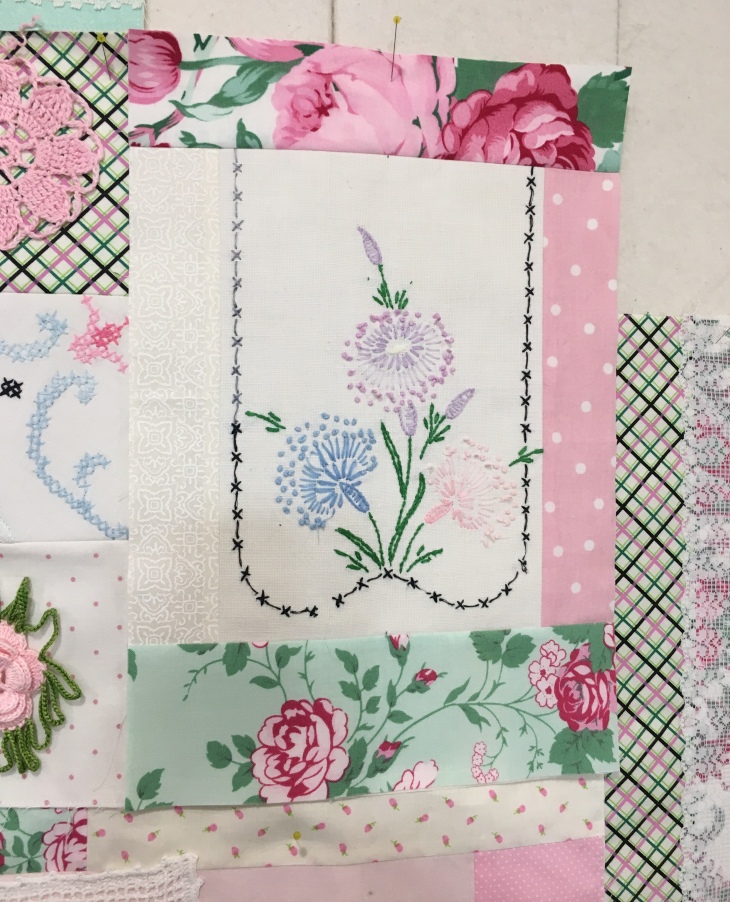
This is the first time I’ve chosen to use such big prints and bold colors with vintage pieces. The bold colors lend their own set of problems to making blocks that are so often comprised of white and/or ivory linens.

The large round doily looks great on the bold floral fabric. Here’s my method for handling the shadowing:
- Center the doily on the fabric square (or rectangle).
- If you have a crocheted edging such as the pic below, machine stitch along the area where the crochet and the doily fabric meet.
- Stitch with a zig-zag or a straight stitch, the choice is completely up to you.

4. Flip your block over. I’ve done both the zig-zag and straight stitch to show you what each will look like. There’s no need to do both stitches on your own blocks. Mine is just for demonstration.

5. With really sharp scissors, make a tiny snip in JUST THE BACKGROUND FABRIC.
6. Insert the scissors into the snip. Begin to cut away the background fabric very close to your stitching, about 1/8″ away. Continue cutting all the way around until the fabric behind the doily is removed.
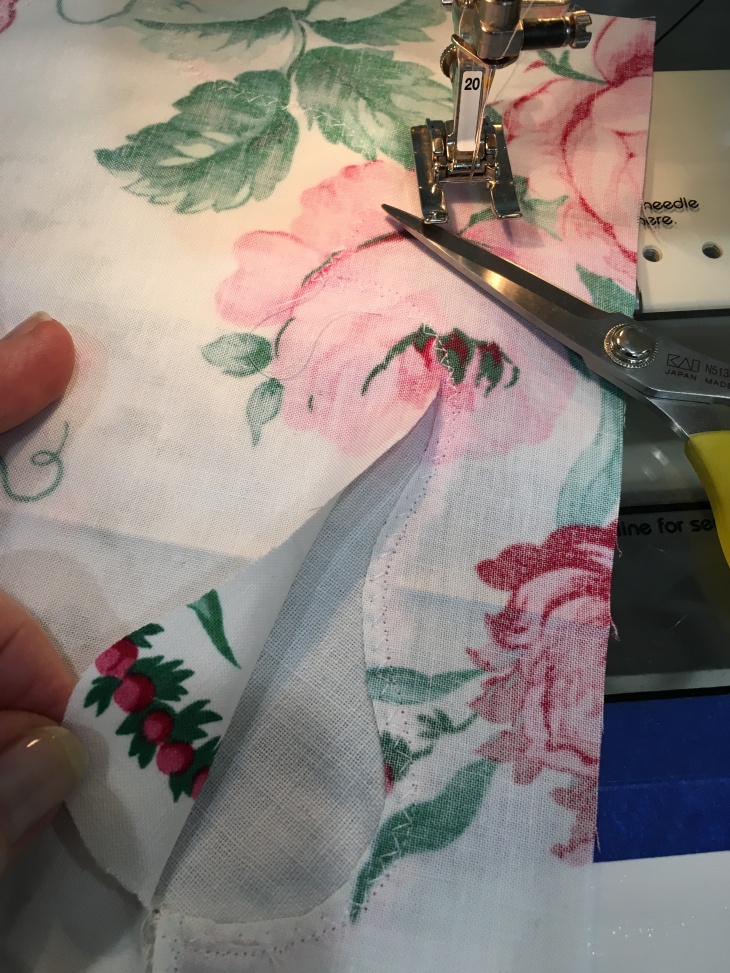
Below is a picture of what your block will look like, but looking closely…what else do you see that is problematic? Look at all those wispy embroidery floss ends flying all over the place! They will show thru to the front side when your quilt top is placed atop batting! Now’s the time to take care of them but first, give the “end game” some thought. Why are you making this quilt? Will it be a utility quilt used on a bed? Will it be a Show Piece in your home? Will you quilt it very closely or will it have mostly wide open un-quilted areas? Because I quilt the living daylights out of my quilts I already know that once loaded on the longarm, I will closely stitch most if not all the embroidery as though it were applique. I also know I am creating this piece as a teaching tool and it will most likely never be used as a utility piece. Therefore I have chosen to clip most of the floss tails to about 1/4″ and then to press them into the floss of like color.
If this were to be a utility quilt I would need to have knotted the floss tails in some fashion to ultimately secure them because as a utility piece the chances of seeing a washing machine and dryer are highly likely.

Let me also tell you that many of the linens had small (less than 1/4″) holes/tears in them. For this project I did not take time to make any repairs, instead I did heavy quilting over these imperfections. See the pic below for one example of such a hole:

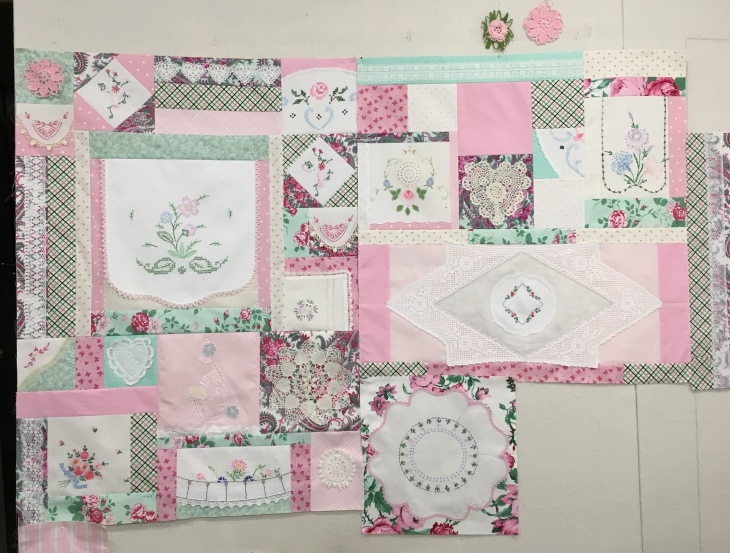
So here we are with the body of the quilt finished! Well, finished with the exception of sewing all 9 sections together.
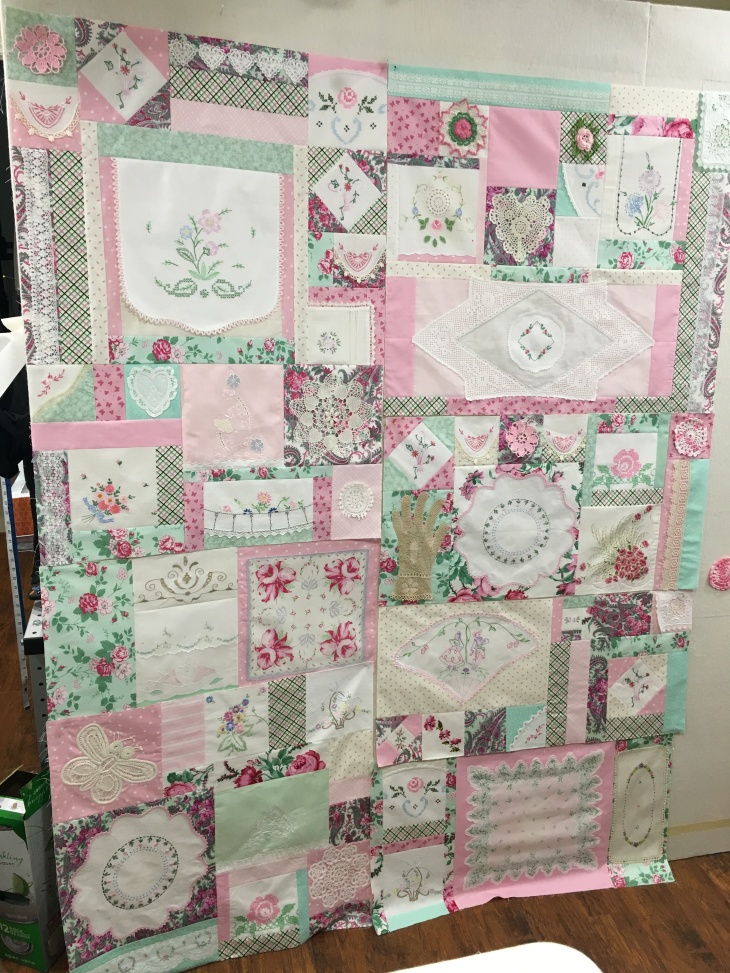
I chose to do 2 borders, the inner 1″ finished and the outer 6″ finished. The outer border features ivory swags cut from a vintage damask tablecloth with shamrock woven designs. I used Heat ‘n Bond Lite behind the swag, pressed it into place and then with a sewing machine built-in applique (blanket) stitch, I appliqued each swag and circle to the borders. The ivory swags and the circles are both raw edge. Many of you know I do not like using fusible with vintage linens so why did I use it on the swags? The damask tablecloth was of medium weight. If I had turned the edges under, the bulk would have been awkward. The damask was also very ravelly. The Heat ‘n Bond Lite held the raw edges very nicely until I could get the applique/button hole stitch completed. For this quilt I chose to make the swag circles from the same fabric throughout the border.
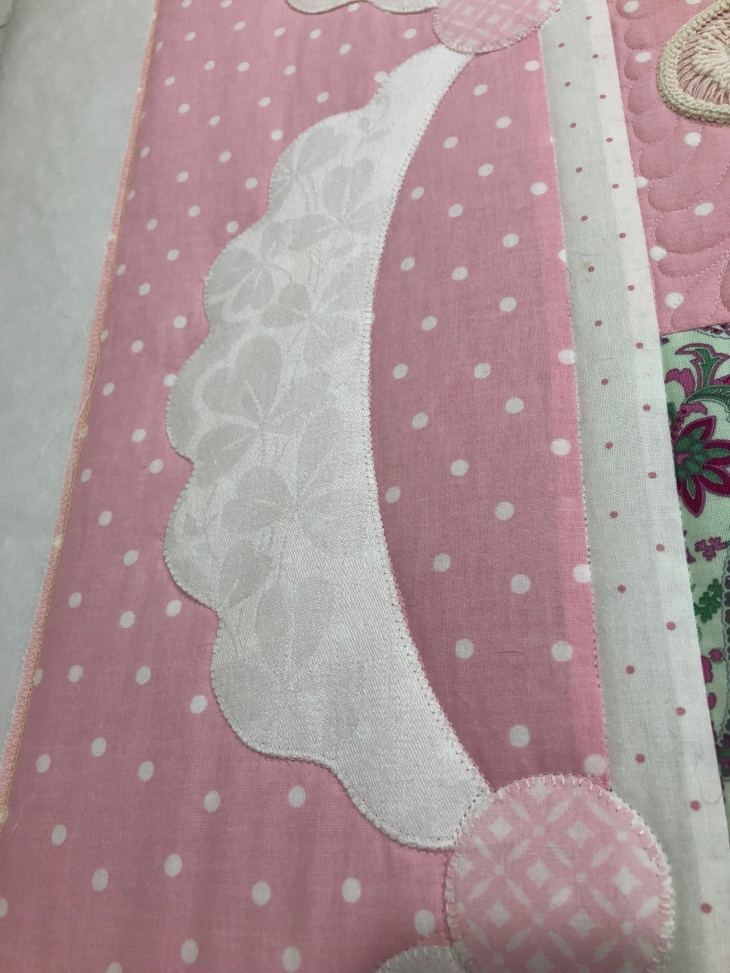
Remember, there’s a very detailed Custom Swag tutorial you can find in my blog post of May 26, 2017. Don’t be intimidated by creating a custom swag border, once you’ve done one you’ll be a pro!
Here’s the quilt top ready to be loaded on the longarm:
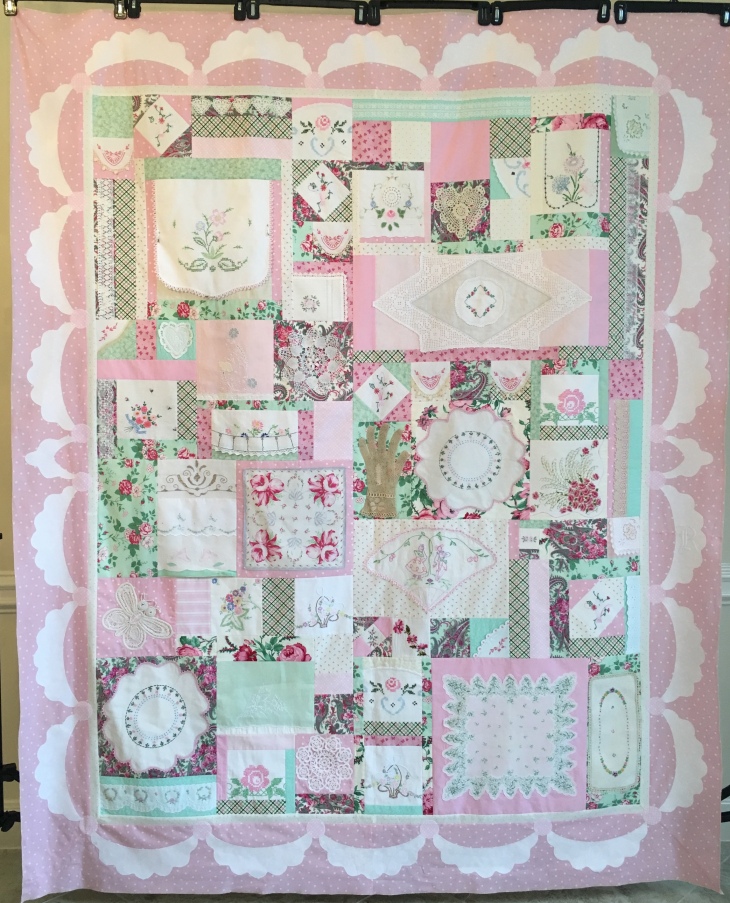
I think there’s one more blog post tutorial about this quilt coming. The final tutorial will detail all the quilting and the tidbits about handling crochet, tatting, laces etc. on your quilt top. I had a bunch of “do-overs” I want to tell/warn you about. What am I doing right now on this quilt? I’ve finished 2 sides of the binding, maybe I will be able to do another side or two this coming weekend. That will leave the sleeve and label for another day.
Thank you so much for all your kind sweet words about the loss of my youngest sister. The funeral service in Chicago was beautiful. I had a chance to speak near the close of the service and while rather difficult, I’ll be forever grateful I did.
Blessings to all and Happy Quilting,
Rhonda
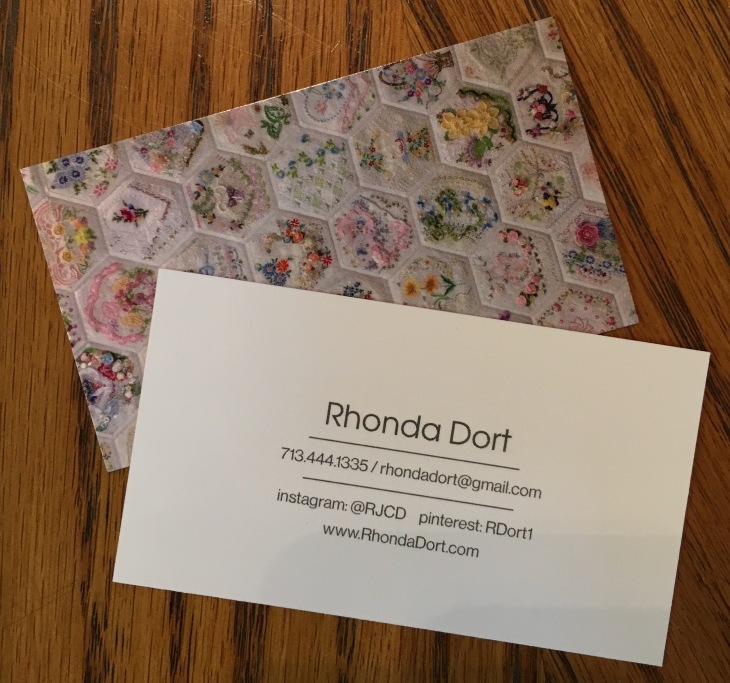


I have not figured out how to access your May 26, 2017 blog tutorial on making a custom swag. Can you help me. I love your swag applique and would like to make one for my Dresden Plate quilt. Thank you.
LikeLiked by 1 person
In the search bar you just need to type may 26 and it should take you right there. Short of using the search bar you can just scroll way way way back…
Or I think you can click on this link I’ve inserted below.
https://rhondadort.com/2017/05/
LikeLike
Hi Rhonda,
I enjoyed these tutorials. For better or worse, they clarified for me that I want to donate my vintage linens rather than making a quilt from them! It’s useful to know what I do and don’t want to do! Thanks!
LikeLike
Well at least you enjoyed the tutorials so I don’t consider it a total loss! 🤣
LikeLiked by 1 person
Beautiful! I love vintage linens. I am on the hunt for them now. I am thinking about buying a longarm quilting machine. It is a large learning and financial commitment. Do you have any recommenations on how to learn to longarm quilt and/or a machine.
LikeLiked by 1 person
Thank you for your kind words! Learning to long arm takes practice and patience! As long as you can do a little of both you will be successful! There is a learning curve but it is easily accomplished!
LikeLike
Me encanta mucho su blog.
LikeLiked by 1 person
Thank you!!
LikeLike
O love what you are doing.
LikeLiked by 1 person
Thanks!!
LikeLike
Your quilt is so stunningly beautiful!! Such a great inspiration to me. Now I know how to proceed
LikeLiked by 1 person
Thank you!! Send pictures of your progress!
LikeLike
Thank you! I have been moving my family’s vintage linens all over Texas. Now I see why and what to make with them! A request for a T-shirt quilt from my granddaughter has gotten me back to sewing.
LikeLiked by 1 person
Happy to have found you! I started mine about a year ago and, without much guidance, I started making blocks. I was pleased to find that a few of my blocks were similar to yours! I love to keep the beatiful crocheted edgings. I usually reinforce the ones with tiny holes with iron on stablizer and a tiny drop or two of fray check. They are always at the most precarious spots–too near the beautiful embroidery. I too have friends and family who feed my addiction to vintage embroidery. In addition, I have a friend who owns her own estate sale company. I usually get first dibs on the vintage linens!
LikeLiked by 2 people
This is my second reply this time. I wanted to thank you so much. I am super excited. Finally tonight I went and got the Fons & Porter hexagon template, beads, ribbon etc. to start the hexagon project. This is giving me something to look forward to. I have had a hard few years and got very overwhelmed.I knew from the first time I saw your beautiful quilts and projects that I wanted to learn from you. I did not know you would be so generous with your talent by sharing step by step details. Thank you again. I hope your home is coming along good and you get your craft room back soon.
LikeLiked by 1 person
First thing is I am so glad you were able to speak at your Sister’s funeral. Even though it was hard I am sure it was a good way to honor her. I have been looking on e-bay to find vintage items. There are many to look at. Yes I did look time and time again. My budget is kind of limited but I am determined to build up a stash. I think I have found a few places to go looking for more. I cannot believe how amazing you are with your beautiful talent. I love your quilts. You are giving so many lessons and ideas for free. That is so kind and loving to do that. My eyes have been opened to so many possibilities. It feels so good to get my creative juices going again. Thank you for the bottom of my heart.
LikeLiked by 1 person
Oh this is going to be gorgeous!
LikeLiked by 1 person
Rhonda, so pretty! I’m curious about how you would repair those tiny tears and flaws. Can you elaborate a bit on that sometime? TIA
LikeLiked by 1 person
I have gotten several inquiries regarding the repairs of these tiny holes. Enough inquiries that I plan on addressing this issue in the fifth and final tutorial post on this quilt. Thanks for your question! It’s a great one!
LikeLike
Incredible work and such a beautiful way to preserve heirlooms .
LikeLiked by 1 person
I want to do beautiful work like this with my vintage linens, and your blogs are inspiring me. Your advice is practical, and it’s great that you’re the voice of experience. Thanks so much and I look forward to the next installment! Love all you do!
LikeLiked by 1 person
Thank you!! 🙂
LikeLike
Thanks, Rhonda, for sharing your quilt and the process you use. Your tips and techniques are wonderful. I noticed how wonderfully pressed your linens were especially edgings which can be rather hard to pin down. Have you covered that before?
LikeLiked by 1 person
No, I haven’t specifically talked about edges, only that I’m a huge advocate of my big cans of spray starch 🙂
LikeLiked by 1 person
Thank you for the challenge of using our antique linens. I love the hexagon piece you have your business card on. Would you show us a close up picture.
LikeLiked by 1 person
Thank you! There’s a blog post, November 5, 2016 all about this embellished hexagon quilt, just scroll back a ways or put the date in the Search Block. Let me know if this is what you’re wanting 🙂
LikeLike
Thanks found it. You are an amazing artist. Love your work and thanks for sharing.
LikeLiked by 1 person
Thank you!!!
LikeLike
Rhonda I am enjoying your blog tremendously. Thank You
LikeLiked by 1 person